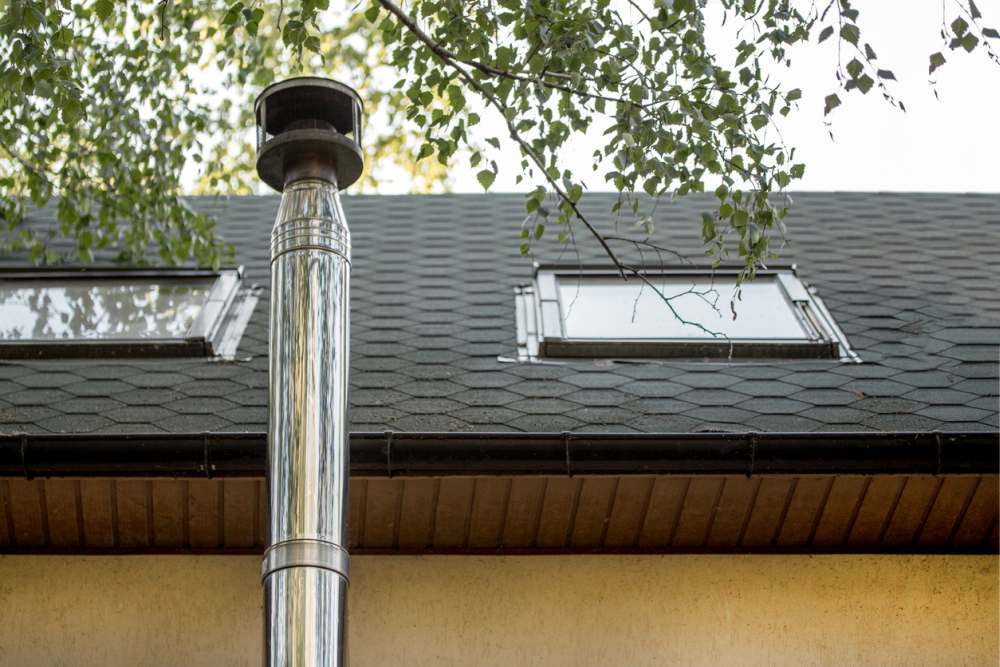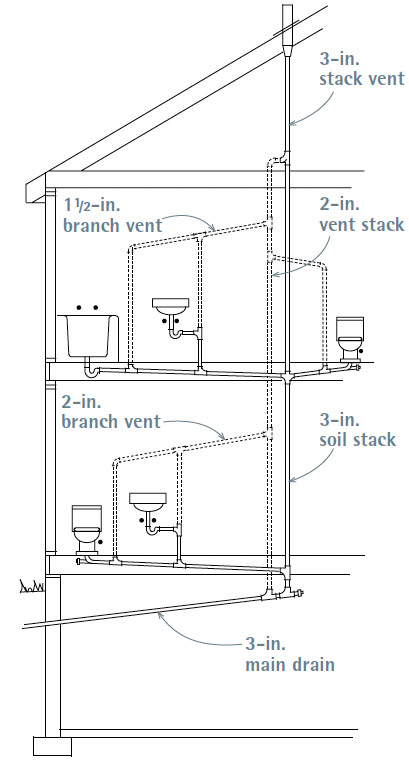The Benefits of Proper Ventilation in Your Plumbing System
The Benefits of Proper Ventilation in Your Plumbing System
Blog Article
Here on the next paragraphs you will discover lots of decent additional info related to What Is A Plumbing Vent & How Do They Work?.

Appropriate ventilation in pipes systems is typically overlooked, yet it is essential for keeping the functionality and security of your home's plumbing. Air flow aids regulate atmospheric pressure, prevent the buildup of dangerous gases, and make certain the reliable elimination of waste. In this overview, we will certainly discover the importance of appropriate plumbing air flow, how it works, and the advantages it gives your plumbing system.
Understanding Ventilation in Plumbing
Ventilation in pipes describes the network of pipelines that permit air to move via the water drainage system. These vents offer multiple purposes, including controling air pressure within the pipes, preventing sewage system gases from getting in the home, and helping in the smooth flow of wastewater.
Exactly How Ventilation Works in Plumbing Equipments
Air Pressure Guideline
Correct air flow preserves balanced air pressure within the pipes system. When water flows with pipes, it displaces air. Without adequate air flow, this variation can produce adverse pressure, resulting in reduce drains or siphoning of water from catches, which can create unpleasant smells to permeate into the home.
Protecting Against Sewer Gas Accumulation
One of the most essential functions of plumbing vents is to prevent sewage system gases, such as methane and hydrogen sulfide, from accumulating within the home. These gases can position severe health and wellness dangers and are highly flammable. Vent pipes permit these gases to get away safely outside.
Helping in Waste Elimination
Air flow aids in the efficient elimination of wastewater by preventing airlocks in the drain system. When air can stream openly via the vents, it permits water and waste to flow efficiently with the pipelines, decreasing the threat of obstructions and backups.
Sorts Of Plumbing Vents
Main Heap Vent
The major stack vent, additionally known as the air vent pile, is the key vent in a pipes system. It prolongs from the major drain line up with the roofing system, permitting gases to leave and fresh air to go into the system.
Branch Vent
Branch vents connect to the primary pile air vent and offer individual components, such as sinks, toilets, and showers. These vents guarantee that each component has appropriate ventilation to work properly.
Air Admittance Shutoff (AAV).
An Air Admittance Valve (AAV) is a one-way valve that allows air to go into the plumbing system without the requirement for a traditional air vent pipe prolonging through the roofing. AAVs are typically made use of in renovations or locations where setting up a common vent is unwise.
Signs of Poor Air Flow in Plumbing.
Slow Draining Fixtures.
If your sinks, tubs, or commodes are draining gradually, maybe an indicator of poor ventilation. Inadequate air circulation can produce a vacuum impact, making it challenging for water to drain pipes correctly.
Gurgling Seems.
Gurgling audios coming from drains are typically a result of air being drawn via water catches because of adverse stress in the pipes. This is a clear sign of insufficient air flow.
Undesirable Odors.
Drain smells inside your home are a red flag that your plumbing system is not effectively aerated. This can mean that drain gases are not being effectively aired vent outside, causing potentially dangerous conditions.
Common Air Flow Blunders.
Insufficient Vent Sizing.
Utilizing small vent pipes can lead to poor air flow and stress imbalances in the system. It's necessary to make use of vents that meet the specific demands of your plumbing system.
Improper Vent Placement.
Positioning vents also much from the fixtures they serve can decrease their performance. Appropriate positioning ensures that air can move openly and successfully with the system.
Ignoring Code Requirements.
Building codes provide specific standards for plumbing ventilation. Ignoring these codes can cause a system that fails to work correctly and might cause costly fixings or health hazards.
Advantages of Appropriate Air Flow.
Improved System Efficiency.
Appropriately aerated plumbing systems run much more successfully, with fewer obstructions, faster draining, and less stress on the pipes. This effectiveness extends the lifespan of the pipes system.
Improved Air High Quality.
By preventing sewer gases from entering your home, correct ventilation adds to better indoor air quality, making your living environment healthier and much more comfy.
Protecting Against Water Damage.
Appropriate air flow aids prevent water from being siphoned out of traps, which can bring about drain gases getting in the home and causing water damage in time.
Steps to Ensure Proper Air Flow.
Consulting Pipes Codes.
Always seek advice from regional plumbing codes when making or customizing your plumbing system. These codes provide the required standards for appropriate airing vent and guarantee your system satisfies safety standards.
Regular Assessment and Maintenance.
Regular assessments can assist identify prospective air flow problems before they come to be significant problems. Maintenance tasks, such as cleaning up vent pipes and checking for blockages, are vital for keeping the system in good working order.
Professional Installation.
For brand-new setups or major alterations, it's important to employ a professional plumbing. They have the expertise to make certain the ventilation system is appropriately developed and mounted according to code.
Final thought.
Correct ventilation is a vital element of any type of pipes system, ensuring that it functions successfully and securely. By comprehending the value of air flow, identifying the signs of poor air flow, and taking actions to preserve your system, you can stop pricey issues and safeguard your home's air high quality.
4 Things You Should Know About Your Plumbing Vents
What Plumbing Vents Are
Also called a vent stack, a plumbing vent is a vertical pipe attached to your drain line that runs through your roof. The plumbing vent pipe, or plumbing air vent, removes gas and odors from your plumbing system and allows fresh air to enter the pipes, helping the water to flow out of the drain pipes.
What Plumbing Vents Do
Plumbing vents have two basic functions. One of which is to allow unpleasant smelling wastewater and sewer gasses to escape your plumbing system instead of entering your home. Plumbing vent pipes are typically located on roofs, away from windows, to ensure the fumes exit the home completely.
The other function of the plumbing vent is to move fresh air into your plumbing system. This helps move water through every plumbing fixture in your house, like toilets and sink drains. Think of the way in which you need to let a little air into the bottle as you pour soda in order to make the drink flow smoothly.
Different Types of Plumbing Vents
True vent: This is the most common vent option. In simplest terms, a true vent is a vertical pipe attached to your drain line that exits through the roof. They often function as the main vent that other fixtures can connect to. Re-vent pipe or auxiliary vent: Attached to the drain line near specific plumbing fixtures, re-vent pipes run up and over to connect to the main vent. Common vent: Two plumbing fixtures installed on opposite sides of a wall are typically tied into the vent stack using something known as a sanitary cross. Wet vent: This venting option operates as a drain pipe and a vent at the same time. Wet vent drainage systems drain water from one fixture while venting the air from another. Although they’ve been used for over 100 years, wet vent systems have only recently been added to the plumbing code in many areas. If you’re planning on installing one in a bathroom remodel, make sure you check your local code prior to construction. Loop vent: For free-standing fixtures like kitchen island sinks, loop vents are ideal. These vent pipes run under the floor, rise from the P-trap, and create a loop inside the cabinet sink. Air admittance valve: An AAV is a one-way mechanical valve typically installed at the site of the plumbing fixture. AAVs allow venting to occur without having to tie into a larger venting system. They’re ideal for venting fixtures where you aren’t able to easily connect to an existing vent system. Common Plumbing Vent Issues
Although vent pipes typically don’t have water flowing through them, they’re still subject to many typical plumbing issues. For example, clogs are one of the most common problems associated with sewer vent pipes. If your vent pipe gets clogged, all of your plumbing fixtures tied into the vent stack will be affected.
A sink with a slow drain that bubbles and gurgles or a strong sewage smell around your toilet are both indicators that your toilet vent pipe is clogged. Because most vent pipes exit through the roof, old leaves, twigs or even a bird’s nest could be clogging the pipe.
Clogs in your vent pipe system cause a buildup of negative pressure, meaning that water won’t be able to flow out of your home very well. It’s similar to putting your finger over the opening of a straw to trap water inside. When you remove your finger, the water is able to flow out of the straw.
If you suspect you have any blockage in your vent, make sure you have a professional come examine the situation. Left unchecked, a blocked air vent can lead to other costly repairs, like leaks and sediment buildup.
Under Pressure
Pipe vents are essential aspects of a home’s plumbing system. Owning a home means learning about all sorts of things you never put much thought into before. But by understanding as much as you can about the important systems of your home, you can keep those budgets intact and those anxiety levels low.
https://www.homeserve.com/en-us/blog/home-improvement/plumbing-vents/

Do you enjoy reading about What Is A Plumbing Vent & How Do They Work?? Put a short review further down. We would be pleased to hear your ideas about this blog. Hoping to see you back again soon. Do you know about another person who is looking into the niche? Be sure promote it. I take joy in your readership.
Click Here Report this page